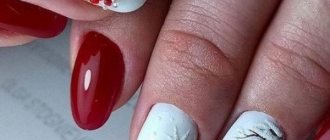Amazing facts about human attractiveness and beauty
Probably everyone wants to look attractive. But at the same time, a logical question arises: is a person’s appearance really a fundamental factor of success and can radically influence life. This review answers this and many other questions related to human attractiveness.
1. Men are more attracted to women whose bone structure is similar to that of their mother. Researchers call this "sexual imprinting." This means that the people one finds attractive as an adult usually look like the people one is used to seeing as a child.
2. People usually look more attractive to a drunk person. Psychologists usually explain this by saying that a drunk person usually notices facial asymmetry less.
3. Women perceive bearded men as having “biological and social qualities that enhance their value as husbands.” At the same time, they consider them “stronger and more active, as well as masculine and physically attractive.”
4. According to most online dating sites, women are most concerned about a potential partner's height. Men are more concerned about the weight of their potential girlfriends.
5. People tend to agree on who is attractive, regardless of race, nationality, or culture. Researchers have noticed that not only does attractiveness vary from person to person, but there are also universal standards for attractiveness.
6. Researchers have found that women prefer masculine, rugged-looking men during ovulation. However, at other times they seek out softer-looking men because they consider them to be socially kinder.
7. For ancient Jews and Christians, physical beauty was a gift from God, and ugliness was a punishment. In fact, physical attractiveness is even mentioned several times in the Bible.
8. The beauty industry has become a profitable industry in most Western countries. Every year, around the world, $200 billion is spent on becoming attractive. This “industry” includes weight loss programs, cosmetics, skin and hair care products, perfumes and cosmetic surgery.
9. Women tend to be more attracted to older men. The researchers explain this by saying that men are able to have children throughout most of their adult lives, and older people tend to have more resources.
10. In most cultures, men find younger women more attractive than older women. This is mainly due to the fact that women are only able to bear children for a limited time.
11. Dr. David Bass, an evolutionary psychologist, has documented the mating preferences of more than ten thousand people from thirty-seven countries and cultures. He came to the conclusion that appearance is in the first (or one of the first places) of any woman.
12. In order to become more beautiful or maintain their beauty during the Middle Ages, rich and noble women ingested arsenic. They also rubbed bat droppings on their skin to improve their complexion.
13. Aristotle was one of the first people to understand the importance of human attractiveness. It.
14. TV news networks tend to report on accidents involving attractive victims rather than ordinary-looking people.
15. For a child, physical attractiveness is often associated with intelligence and friendliness. That is why when a child chooses his friends, they are usually smarter and kinder than him.
16. Someone accused of raping an unattractive victim is less likely to be found guilty than someone accused of raping an attractive victim.
17. Physically attractive people tend to have better-paying jobs and higher-level positions than their less attractive colleagues. This preference is commonly referred to as the "beauty bias."
18. Researchers suggest that men perceive highly attractive women as less capable of completing a difficult task. In this regard, preference is given to unattractive women.
19. Research has shown that students tend to evaluate the professional qualities of their female teachers based on their physical attractiveness, rather than their ability to communicate.
20. Children born to parents who had them in their 30s or older tend to find older people more attractive than children born to parents in their twenties.
21. Teachers expect beautiful students to study well. This fact often leads to less severe punishment for these students and higher grades given to them.
Female beauty: historical facts
Paid surveys Bitcoin news
beauty and health
In different historical eras, ideas about the beauty of women have changed.
Centuries passed, monarchs, fashion and weather changed, but only natural female beauty remained unchanged, and the appearance - that which is influenced by hygienic and cosmetic procedures - changed depending on the time era.
In Egypt, three and a half thousand years ago, the model of beauty was Nefertiti, a woman with a slender, boyish figure. The portrait of Nefertiti is memorable for its expressive eyes, thin eyebrows, and the correct line of the mouth, and one gets the impression that this charming appearance is the result of the interaction of natural beauty and art.
Oils, incense and first mascara
Egyptian women of that era used lipsticks, powder compacts, containers with nail paints, spatulas for applying cosmetics, as well as razors and tweezers to remove unwanted hair when taking care of their appearance. According to the Egyptians, the skin should be smooth, clean, soaked in oils and incense, so they carefully removed every stray hair from the skin. Simultaneously with such trends widespread in Egypt, the image of a beautiful woman was also formed in India, Japan, and China. They made balms, extracts, and incense. Amber, tansy, tuberose are plants that are native to these countries. Mascara was invented here and nail polish first appeared here. Persian cosmetologists became the authors of the invention of Rose Shiraz oil, rose water, and almond milk. Japanese makeup, baths with incredibly hot water, appeared much earlier than the cosmetic art of the Roman Empire could develop.
Woman's skin
Modern women, regardless of age, strive to create a beautiful tan in the sun. In Rome and Greece, first of all, very white and delicate skin was valued, and the fair sex worked to lighten it, using all kinds of means. For example, for this purpose they could use cream made from bread with milk, wash their face with soap made from goat fat, add beech tree ashes to cosmetics - these are just a few of the remedies that were common in Greece and Rome. The Roman Empress Poppaea never went a single day without bathing in milk, and if she traveled, 500 donkeys went with her, giving her milk for her baths.
The Romans revealed their beauty secrets, which in our era only cause ridicule. For example, a beauty product with the following ingredients: nut and date kernels should be ground with rose petals and crushed crocodile feces should be added to this mixture (secret!). Taking baths with the addition of various aromatic substances to the water was completed with massage procedures, which Greek slaves mastered to perfection. Women of that era valued skin care in the form of milk baths and milk washing.
Hairstyles
Hairdressers in Rome invented new hairstyles every season. If in the spring the Greek hairstyle was considered the latest fashion, then in the fall Egyptian curls were already popular. An example of the hairdressing art of those times is the sculpture of Empress Faustina, whose curls were distinguished by impeccable strokes. In ancient times in Rome, as now in Italy, white curly hair was considered the standard of beauty.
What happened in Europe?
Here art was not sufficiently developed - there was a barbaric era in the yard as a result of the invasion of the Huns. Even rare cultural traditions that could exist in Europe were forgotten. Showing the delights of a naked body, as happened in Ancient Rome, was considered a shame. Low cultural values, lack of sanitation, lack of running water - all this excluded the possibility of visiting a bathhouse, where it would be possible to provide the body with high-quality care with every luxury. When the plague epidemic began in Europe, the baths were closed altogether.
But the knights of the Middle Ages who took part in the crusades met representatives of the fair sex who tirelessly worked on the beauty of their appearance in all available ways. The knights brought home balms, essences, and valuable cosmetics borrowed from the Seljuks, Turks, Moors, and Arabs. But such little-known things could not necessarily be used for their intended purpose. In relation to cosmetics, magic, alchemy, and the search for the philosopher's stone were discerned. Cosmetics were dealt with by charlatans who dressed up in pointed caps and moved from one fair to another. It was a time of believing in the most meaningless things. If someone had striking beauty, it became unsafe for him, because it was believed that such appearance could only be obtained through a deal with the devil.
This darkness was dispelled by the influence of the Renaissance, when crafts and various types of arts were activated. The ideals of beauty are affirmed, the harmony of ideals in the reality of life is achieved, and interest in women's appearance flourishes. Poets idolize beauties, artists create impressive images on their canvases. That’s when face and body care products become necessary again.
The first European nation to experience a “cosmetic” revival is Venice. Venetian women became recognizable by their flame-colored hair. The color red was immortalized by Titian in his works of art. Venice was famous for beautiful women, masquerades, and unrivaled mirrors. It is not surprising that men from all over the world came here in search of their soulmate. A trip to Venice was akin to a trip to the “promised land” for men of noble birth.
The Renaissance era is remembered for such features of the female ideal as splendor. Artists depicted loose female figures of a pale color on their canvases.
A distinctive feature of the Rococo era is the neglect of basic hygiene standards. During the reign of King Louis XIV, people washed themselves with cologne and applied it to their face and hands. It is known that Marie Antoinette did have a silver bath, but it was served at the queen’s request extremely rarely. They said about the king that he takes a bath only in the spring. To muffle the stench of an unwashed body, the courtiers resorted to perfumes, powders, and various lipsticks. Exquisite hairstyles cost a lot of money, so the ladies did not sort them out or wash their hair for a week, not to mention taking a shower. Such an attitude to hygiene created all the conditions for the proliferation of moths, fleas, and lice.
In the era of French gallantry, two more significant attributes of beauty were to be discovered, which remain unchanged to this day - high heels, which contributed to graceful movements, as well as silk stockings, which attracted the eye to the beauty of women's legs. Beautiful legs were once again revealed, and Paris took its rightful place in the field of fashion creation.
Many revolutionary extremes in fashion were annulled, but high shoes, silk stockings and cleavage, as well as powder and lipstick, have not lost their popularity to this day. Curls have become fashionable, the color of curls - from light golden to rich black. Representatives of French classicism gradually brought water and detergents back into life. Preference was given to the ideals of beauty of Antiquity, although in parallel with this, opposite trends arose, represented by Napoleon’s wife, Empress Eugenie, who wore crinolines covering her legs. Queen Victoria also had her say regarding the "indecently exposed" legs. When Victoria appeared in her long skirt, its hem raised columns of dust as she walked. But the well-known poet Byron spoke out against hypocrisy, and the number of his fans grew: then natural female beauty again rose to its well-deserved heights.
Looking at photographs of bathers at the beginning of the century, you will see women dressed from head to toe in costumes that protected them from water and sun. Bulky swimsuits, instead of the desired comfort, limit movement and only allow your teeth to chatter from the cold, and women feel as if their body is “packed” in a tight bag. Thanks to the development of sports, sun and fresh air are becoming popular. The Olympic Games also played an important role. Sportswear is becoming popular. Women wear tennis skirts, open swimsuits, and ski pants.
20th century
In the 20th century, a great art came to life - cinema, the development of which would not have been possible without the participation of beautiful actresses. The camera did not leave a single mystery of the woman's face. Therefore, the once secret knowledge of beauty care has turned into a cosmetic monster, and inaccessible products have become a mass product for millions of women. Today, every woman understands that the effect of appearance largely depends not on natural beauty, but on those advantages that should be skillfully emphasized with the help of cosmetics and clothing.
Of course, not every woman can look like a movie star, but any woman can present her winning features while hiding her flaws. Systematic care allows you to maintain a youthful and fresh appearance for many years, which means getting closer to the ideal of female beauty.
Subscribe to our channel on Telegram @astroguide_ru
beauty women means of the era women's means rome beauty time curls
| + |









